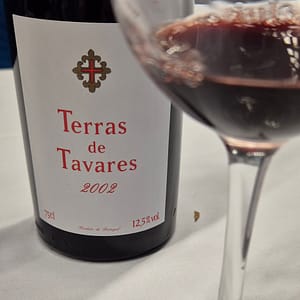I have participated in a tasting with some of Vinmonopolet’s suppliers, organized by the Norwegian state monopoly. The relatively new importer Swirl has a portfolio that focuses on Portugal. Øystein Solvang presented a veritable wave of individual vignerons from various corners of the country, all of whom demonstrated high quality and a large degree of sustainable production. Here I can only name a few. Among those I already have a close relationship with, and which you can read more about on the blog, were Aphros (Minho), Espera and Marinho (both Lisboa), Vitor Claro (Lisboa and Alentejo), Cebolal (Setúbal/Alentejo) and Muxagat (Douro).

Among those who were new to me are Tabodella and Hugo Pinheiro, both from Penalva do Castelo in Dão, who represented two different approaches. Where Tabodella had a more classic cut, Pinheiro offered a distinctly fruit-driven, unfiltered style.

A strong impression was made by tasting wines from João Tavares de Pina, also from Penalva in Dão, with the following background. Tavares recently lost his house and 85% of his vineyards in the fire that has ravaged the interior of Portugal. He is a sociable and generous guy with many friends, and there is currently a large-scale campaign underway in Portugal and partly abroad for him to be able to replant the vineyards. João says that the best you and I can do to help is to buy his wines. I have myself bought a couple of cases recently.

Here I tasted a wonderfully developed wine, Terras de Tavares 2002, with a brick-red color, aromas of dried fruit, well-hung meat, prunes and a hint of smoke. This evoked memories of an evening at the home of João and his wife Luisa, with a fire on the fireplace in the cold winter, when we enjoyed delicious food prepared by João himself and also had a similar wine (Terras de Tavares 1997, read about it here).
I said hello to 2 x Ole Martin. It was the first time I had met Ole Martin Alfsen, who is known in several disciplines of gastronomy and wine. -Now it’s mostly wine, he says. He has developed his own portfolio of wine made in collaboration with producers in several countries, often abbreviated to his initials OMA. He always hits the mark with quality at reasonable prices. The wine name XinOma probably says it all; it is made by him on the grape xinomavro. Ole Martin also tells how he works in collaboration with producer Oenops. This grape often produces light coloured wines. The wine is light, but also has a nice concentration, with good primary fruit and an aroma of flowers and herbs.

We also tasted a rosé version of the same wine, a pét-nat and a blaufränkisch made in collaboration with Heinrich in Gols, Austria. Ole Martin also talked about his collaboration with Loimer in Austria, Quintas de Melgaço in Portugal, Giovanni Rosso in Italy and Au Bon Climat in the USA. Finally, we tasted a pinot noir, in which Ole Martin had collaborated with Broc Cellars in Santa Bárbara, California. It’s a fruity, mellow wine. It has a touch of oak, but Ole Martin Alfsen knows better than anyone that such wines also have a place on the table.

At importer Vinarius, Ole Martin Brodvall served wines from the prominent Fitapreta, where António Maçanita is the winemaker. First we tasted a phenomenal white wine from typical Alentejo and Portuguese grapes, mostly arinto. Palpite 2022 had a clean and beautiful fruit with hints of apricot and orange peel and good body, together with a significant acidity. Fitapreta Tinto 2022 was a relatively light and luscious wine with aromas of red berries with balsamic hints, from a typical Alentejo blend. Tinta Carvalha 2022 was also light in colour. Red berries, cherries and a hint of anise and other spices, good length. A good ambassador for the region..

I also met Henriette Batt, who has worked for importer Engelstad for many years. One of the producers she presented was Herdade do Rocim, which is known as one of the leading producers of vinho de talha, clay-aged wine, in Alentejo, Portugal. They also host a festival for clay-based wines. Fresh from Amphora 2023, which came in a 1L bottle, was a textured white. Discreet aroma, but with a mineral and spicy character, with a great and fruity middle part and a salty finish. The red in the 22 vintage has 40% moreto and has a fine touch of cherry and stone fruit, clean and lovely.

I was running out of time, so I indulged myself with just a few highlights from several importers. John Sonnichsen (VinJohn) served wine from his colleague Autentico. I tried MA Doña Blanca 2022 from producer Mufatto, who is Argentinian but operates in Bierzo, Spain. There doña blanca finds itself in the shadow of godello. But it stands out: Light in colour, rich with almonds, a bit of spice, good lees character, well-integrated barrel. A great wine, good for medium-term storage.

It is always a pleasure to try wines from the Spanish producer Envínate. Ove Kvalheim at Unico had brought the white Benje 2023 from Tenerife, that is made of palomino fino and has been under a thin layer of flor, but without skin contact: Light in colour, rich, ripe citrus, nuts, fine texture. Superb. Lousas Viñas de Aldea 2022: Bright red, great berry fruit, with some pepper, a cool touch, nice concentration. I also tasted António Madeira‘s red Vinhas Velhas 2021, an elegant wine from a relatively cool vintage and two wines from Areanna Occhipinti. The normal SP68 in the 23 vintage lived up to the usual standard. Siccagno Nero d’Avola 2021 had a wonderful fruit, with flowers and discreet spice, young tannin, great acidity, juicy and concentrated at the same time and good length.





